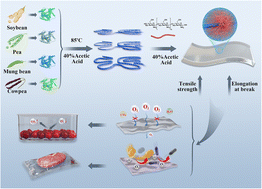Protein fibrillation and hybridization with polysaccharides enhance strength, toughness, and gas selectivity of bioplastic packaging†
Abstract
Edible bioplastic films used for the preservation of perishable products are urgently needed to prevent food waste and eliminate hunger crises. However, bioplastic film applications are always limited by the tradeoff between strength and toughness; as one increases, the other decreases. In addition, the utilization of bioplastic films as the passively modified atmosphere packaging of fruits is always difficult to realize due to their low selectivity coefficient for CO2/O2. In the present study, plant protein fibrillation and hybridization with polysaccharides were demonstrated to simultaneously enhance both the tensile strength and elongation at break of bioplastic films prepared via the thermal acidic treatment of soybean protein isolate (SPI) and chitosan. Furthermore, the SPI nanofibril–chitosan films were found to have selectivity coefficients for CO2/O2 of more than 100, which is the highest value reported to the best of our knowledge and more than 10 times higher than those of other reported films. Crosslinking of the composite films with a low content of citric acid increased their tensile strength and water resistance, which decreased their elongation at break. The hybrid bioplastic films acted effectively as the passively modified atmosphere packaging of perishable fruits, including cherry and strawberry, and an optimum high-CO2 and low-O2 atmosphere of the packaging interior was spontaneously attained to delay fruit post-ripeness for up to five days. Consequently, an edible rate of approximately 75% was achieved after the storage of cherries for 7 days and strawberries for 5 days. Wrapping beef with the citric acid-crosslinked bioplastic films with high wet stability was demonstrated to effectively prevent the spoilage of meat by inhibiting chemical (oxidization) and bacterial deterioration. The edible bioplastic films could be totally recycled and regenerated, and they were completely degraded in nature, avoiding the environmental pollution and biological hazards caused by microplastics. Therefore, this study provides a facile, effective, sustainable and universal strategy for developing edible bioplastic films with high strength and toughness as well as high gas selectivity for the preservation of perishable products.



 Please wait while we load your content...
Please wait while we load your content...